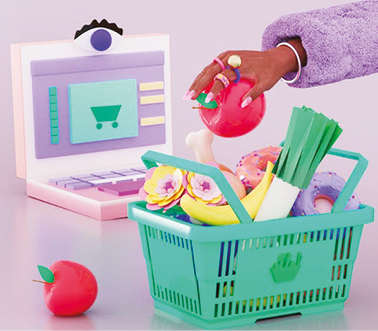Click and mortar: Why we can’t predict grocery’s e-future
I have been scouring data on online grocery shopping in the U.S., and I will be humble and say that I don’t have a clear picture.

The conventional wisdom has been that the pandemic will spark a widespread and permanent shift in American habits from analog to digital. But what about that most basic habit — grocery shopping? Americans spend more on groceries than almost anything else, and how we buy food is considered a finger in the wind to assess the future of our shopping habits. Right now, the direction is … unclear.
I have been scouring data on online grocery shopping in the U.S., and I will be humble and say that I don’t have a clear picture. Americans are definitely buying far more groceries online than we were in 2019, but in some notable categories such as fresh and frozen foods, the growth of online sales is much lower than it was before the virus started to spread widely in the U.S. In some recent months, online grocery sales have dropped or barely budged from the prior year. It’s inescapable that digital sales will keep increasing as a share of U.S. spending, including for groceries. But digital transformation is often not a straight march up a mountain but more of an uneven climb up, down and sideways. And grocery buying has been on a particularly jagged trajectory.
My wishy-washy analysis is that Americans haven’t fallen head over heels for buying bananas over the internet, but we aren’t rejecting it, either. Along with the figures that showed e-commerce lost ground last year to shopping in person, the muddy picture of online groceries shows human behavior may be too complicated for explanations.
Before 2020, Americans weren’t that jazzed about having groceries delivered to our doors. By choice or necessity, almost all U.S. grocery buying happened in stores. The amount of grocery purchases made online has increased to somewhere around 7 to 15 percent from perhaps 3 or 4 percent of total sales in 2019. Grocery delivery to our door is still relatively dinky, but ordering groceries online for pickup at the store took hold during the pandemic and is sticking. Maybe.
There’s been some backsliding on online ordering, however, and the vast majority of Americans are still shopping for groceries the old-fashioned way. It’s tough to assess whether and how much the online-grocery habit might stick. A report by Forrester and IRI found that in many categories of products purchased in supermarkets, online growth is lower than it was in January 2020. In closely watched shopper surveys by the research firm Bricks Meets Clicks, online grocery sales have been growing unevenly recently.
It’s not a surprise that online grocery sales couldn’t keep increasing as quickly as they did when we were internet panic-shopping in 2020. But with the sales still relatively small, it’s not a sign of passionate digital love that the numbers haven’t been going up quickly or steadily. (Rising costs for everything also make it tricky to compare 2022 shopping with that in 2019.)
Even experts can’t confidently say how quickly Americans will adopt the online-grocery habit or how much of our shopping may wind up virtual. “The numbers are too small to draw permanent conclusions,” said Jason Goldberg, the chief commerce strategy officer at the advertising giant Publicis. The difficulty of analysing our online-grocery present and future calls for humility about the durability of our adaptations to the coronavirus. When people make bold statements about what will happen in shopping, work or the economy, try to remember that no one knows anything for sure.
Ovide is a tech writer with NYT©2022
The New York Times
Visit news.dtnext.in to explore our interactive epaper!
Download the DT Next app for more exciting features!
Click here for iOS
Click here for Android



